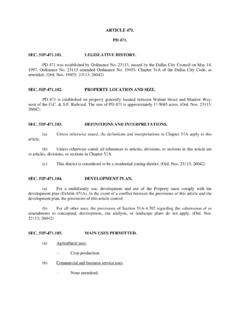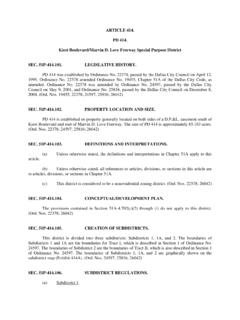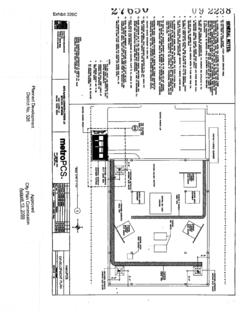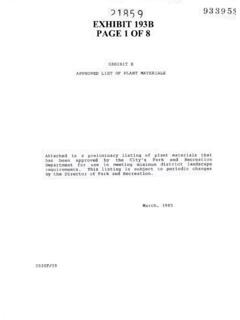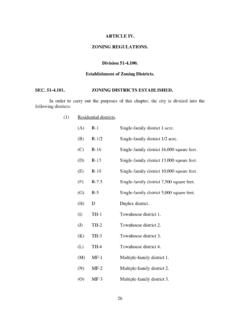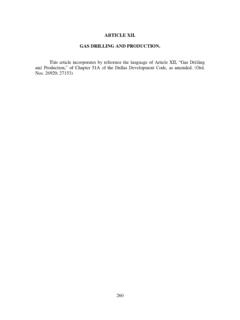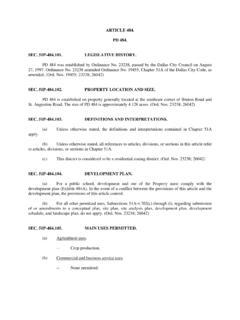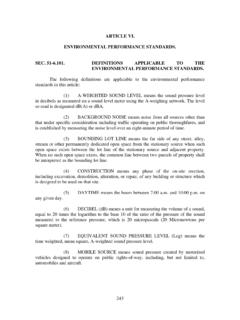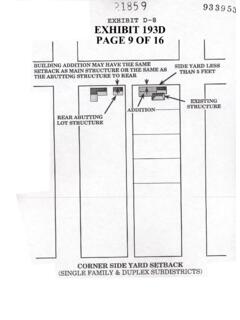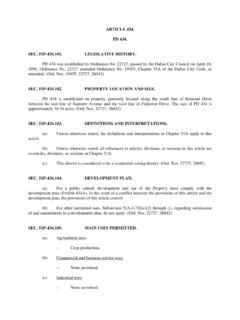Transcription of SEC. 51-4.217. ACCESSORY USES. - Dallas City Hall
1 SEC. ACCESSORY uses . (a) General provisions. (1) An ACCESSORY use must be a use customarily incidental to a main use. An ACCESSORY use not listed in Subsection (b) is permitted if the ACCESSORY use complies with Subsection (a). (2) Except as specifically permitted in this article, no use listed in Sections through may be an ACCESSORY use. (3) Except as otherwise provided in Subsection (b) or in Sections 51- through , an ACCESSORY use is permitted in any district in which the main use is permitted. (4) Except as otherwise provided in Subsection (b), an ACCESSORY use must be located on the same lot as the main use, and must not be across a street or alley from the main use. (5) Unless otherwise specifically required in this article, an ACCESSORY use must comply with all regulations applicable to the main use. (6) An alcohol related establishment that is customarily incidental to a main use, such as an alcohol related establishment within a hotel, restaurant, or general merchandise store, will be considered as part of the main use when determining the gross revenue derived by the establishment from the sale of alcoholic beverages for on-premise consumption.
2 (b) Specific ACCESSORY uses . The following ACCESSORY uses are subject to the general provisions in Subsection (a) and the regulations below: (1) Game court (private). (A) Definition: Court for engaging in tennis, handball, racquetball, or similar physical activities. (B) Districts permitted: Residential and nonresidential districts. This ACCESSORY use is not permitted in the P district. (C) Required off-street parking: (i) Three spaces for each game court. (ii) No off-street parking is required for a game court ACCESSORY to a single-family or duplex use. 187. (D) Required off-street loading: None. (E) Additional provisions: (i) This ACCESSORY use may occupy no more than 50. percent of the area of the lot containing the main use. (2) Swimming pool (private). (A) Definition: A swimming pool constructed for the exclusive use of the residents of a residential use. (B) Districts permitted: Residential and nonresidential districts.
3 This ACCESSORY use is not permitted in the P district. (C) Required off-street parking: None. (D) Required off-street loading: None. (E) Additional provisions: (i) No private swimming pool may be operated as a business, except that private swimming lessons may be given under the home occupation use. (ii) No private swimming pool may be maintained in such a manner as to be hazardous or obnoxious to adjacent property owners. (iii) No private swimming pool may be constructed in the required front yard. However, a private swimming pool may be located within the required side or rear yard if it meets the requirements of Section (a). (iv) A private swimming pool must be surrounded by a fence. (3) Private stable. (A) Definition: An area for the keeping of horses for the private use of the property owner. (B) Districts permitted: Residential districts except MH, and nonresidential districts except NO, LO, MO, GO, and P districts. (C) Required off-street parking: None.
4 (D) Required off-street loading: None. 188. (E) Additional provisions: (i) A private stable is permitted only on a lot that has at least 15,000 square feet and a person may keep only the number of horses permitted for the lot area as described in the following chart: Number Lot Area of Horses At least 15,000 sq. ft. but less than 21,780 sq. ft. 1. At least 21,780 sq. ft. but less than 43,560 sq. ft. 2. At least 43,560 sq. ft. but less than 87,120 sq. ft. 3. At least 21,780 sq. ft. per animal 4 or more (ii) A private stable must include a pen or corral containing at least 800 square feet for each animal with a stable under a roof containing at least 100 square feet for each animal. (iii) A stable must have proper drainage so as not to create offensive odors, fly breeding, or other nuisances. (iv) The owner of a private stable shall collect manure at least once a day and place it in a concrete or metal flyproof container, and cause the manure to be removed from the premises at least once a week.
5 (v) A pen, corral, fence, or similar enclosure may not be closer than 20 feet to an adjacent property line. The widths of alleys, street rights-of- way, or other public rights-of-way may be used in establishing the 20-foot distance to the adjacent property line. (vi) Fences for pens, corrals, or similar enclosures must be of a sufficient height and strength to retain the horses. (4) Home occupation. (A) Definition: An occupation that is incidental to the primary use of the premises as a residence and is conducted on the residential premises by an occupant of the residence. (B) Districts permitted: All residential districts and nonresidential districts except I-3 and P districts. 189. (C) Required off-street parking: None. (D) Required off-street loading: None. (E) Additional provisions: (i) A person who engages in a home occupation shall not: (aa) use an advertisement, sign, or display relating to the home occupation on the premises.
6 (bb) use a street address of the premises on an advertisement, sign, or display off the premises;. (cc) involve more than three people on the premises at one time, other than the residents of the premises;. (dd) employ more than one person other than the occupants of the residence;. (ee) conduct any activities relating to the home occupation, including activities on any porch, deck, patio, garage, or unenclosed or partially enclosed portion of any structure, unless conducted entirely inside the main structure;. (ff) use equipment other than ordinary household equipment;. (gg) generate loud and raucous noise, that renders the enjoyment of life or property uncomfortable or interferes with public peace and comfort;. (hh) sell or offer or advertise products of the home occupation at or on the premises;. (ii) generate vehicular traffic that unreasonably reduces the availability of on-street parking spaces on surrounding streets; or (jj) generate parking congestion that unreasonably reduces the availability of on-street parking spaces on surrounding streets.
7 (ii) A home occupation may not occupy more than 25. percent or 400 square feet of the total floor area of the main structure, whichever is less. (5) Occasional sales (garage sales). 190. (A) Definition: The sale of tangible personal property at retail by a person who is not in the business or does not hold himself or herself out to be in the business of selling tangible personal property at retail. (B) Districts permitted: Residential districts, and nonresidential districts except I-3 and P districts. (C) Required off-street parking: None. (D) Required off-street loading: None. (E) Additional provisions: (i) A person shall sell tangible personal property only on the premises of the owner or lessee of the premises where the sale is conducted, and the owner or lessee must be the legal owner of the tangible personal property at the time of the sale. (ii) The sale must be inside the building or garage, or on the patio of the premises.
8 (iii) A person shall not sell, offer, or advertise for sale merchandise made, produced, or acquired solely for the purpose of resale at an occasional sale. (iv) A person shall not conduct an occasional sale for a duration of more than three consecutive calendar days. (v) A person shall not conduct more than two occasional sales at a premise during any 12-month period. (vi) A person shall not place more than one sign, not to exceed two square feet, upon the lot where the sale is taking place. Any other signs at any locations remote from the sale property are not permitted. (vii) Any advertisement of an occasional sale or of an item being offered for sale at an occasional sale must contain the street address at which the sale will occur and the date(s) on which the sale will occur. (6) Community center (private). (A) Definition: An integral part of a residential project or community unit development that is under the management and unified control of the operators of the project or development, and that is used by the residents of the project or development for a place of meeting, recreation, or social activity.
9 191. (B) Districts permitted: Multiple-family, MH, O-1, O-2, GO, commercial, and central area districts; limited use in LO and MO districts; specific use permit required in all single-family, duplex, TH, I-1, and I-2 districts. This use is not permitted in the P district. (C) Required off-street parking: One space for each 100 square feet of floor area. (D) Required off-street loading: None. (E) Additional provisions: (i) A private community center may not be operated as a place of public meetings or as a business. (ii) The operation of a private community center must not create noise, odor, or similar conditions beyond the property line of the project or development site. (iii) A liquor permit may not be issued for a private community center. (iv) This ACCESSORY use need not be located on the same lot as the main use. (7) Amateur communication tower. (A) Definition: A tower with an antenna that transmits amateur radio, citizen band, or both spectrums, or that receives any portion of a radio spectrum.
10 (B) Districts permitted: All residential and nonresidential districts. This use is not permitted in the P district. (C) Required off-street parking: None. (D) Required off-street loading: None. (E) Additional provisions: (i) In all residential districts except MF-3 and MF-4, a person may erect one amateur communication tower that exceeds the maximum height specified in Section , if the amateur communication tower: (aa) does not exceed 60 feet in height;. 192. (bb) is setback an additional 12 inches from the required front, side, and rear yards for each additional 18 inches of height above the maximum height specified in Section ;. (cc) has a maximum horizontal cross-sectional area of three square feet;. (dd) has no more than two antennae above the maximum height specified in Section with a maximum volume of 900 cubic feet for a single antenna and 1400 cubic feet for two antennae. In this provision, antenna volume is the space within an imaginary rectangular prism which contains all extremities of the antenna.
